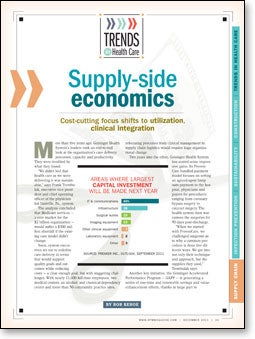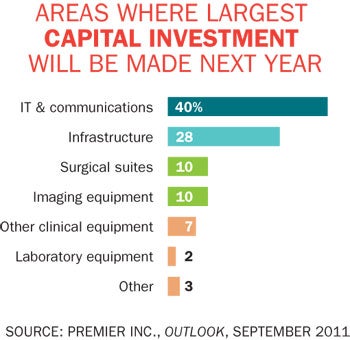Supply-side economics
 More than five years ago, Geisinger Health System's leaders took an end-to-end look at the organization's care delivery processes, capacity and productivity. They were troubled by what they found.
More than five years ago, Geisinger Health System's leaders took an end-to-end look at the organization's care delivery processes, capacity and productivity. They were troubled by what they found.
"We didn't feel that health care as we were delivering it was sustainable," says Frank Trembulak, executive vice president and chief operating officer of the physician-led Danville, Pa., system.
The analysis concluded that Medicare services — a core market for the $2 billion organization — would suffer a $300 million shortfall if the existing care model didn't change.
Soon, system executives set out to redefine care delivery in terms that would support quality goals and outcomes while reducing costs — a clear enough goal, but with staggering challenges. With nearly 11,000 full-time employees, two medical centers, an alcohol- and chemical-dependency center and more than 50 community practice sites, refocusing processes from clinical management to supply chain logistics would require huge organizational change.
Two years into the effort, Geisinger Health System has scored some impressive gains. Its ProvenCare bundled-payment model focuses on setting an agreed-upon lump sum payment to the hospital, physicians and payers for procedures ranging from coronary bypass surgery to cataract surgery. The health system then warrantees the surgeries for 90 days post-discharge.
"When we started with ProvenCare, we challenged surgeons as to why a common procedure is done five different ways. We got into not only their technique and approach, but the supplies they used," Trembulak says.
Another key initiative, the Geisinger Accelerated Performance Program — GAPP — is generating a series of one-time and renewable savings and value-enhancement efforts, thanks in large part to improved focus on clinical management and the supply chain.
Closing the gap
In fiscal years 2010 and 2011, the supply chain team has generated more than $20 million in savings — a figure Trembulak believes will triple in coming years as innovation continues. Focusing on ways to remove cost permanently, the team has redefined its mission to better support care delivery.
That has translated into negotiating better contracts, getting products and drugs closer to the point of care and removing unjustified variation in the purchase of medical devices and other products. At the same time, supply chain leaders are building greater trust with physicians and nurses by assuming greater responsibility for supply-related activities.
While the numbers and details may differ by organization, many U.S. hospitals and health systems are undergoing similar transitions.
More often than not, supply chain leaders are playing a key role in the process. That's because supply costs typically account for 30-40 percent of a hospital's operating costs. Just how successful hospitals will be in reengineering their cost structures while meeting quality goals will go a long way toward determining whether they can meet their future staffing, building, technology and other needs.
Scott Downing, executive vice president of sales and marketing at VHA Inc., Irving, Texas, says supply chain innovations will become an increasingly important strategic focus for health care organizations in 2012 and beyond as providers try to create a more sustainable economic model in the post-reform era.
For many organizations, he notes, this will require reducing overall operating expenses by 15-20 percent, with supply chain expected to be a main contributor to the savings push.
"This puts tremendous pressure on the price line, but it's also forcing organizations to really look at practice variation within the clinical supply chain," Downing says.
Jake Groenewold, senior vice president of supply chain services for University HealthSystem Consortium (UHC), Chicago, finds a similar situation among his organization's members.
"Our members are asking, 'Can I make money minus 5 percent from where my Medicare line is today?' That's the bottom line," Groenewold says.
If hospitals are going to meet this threshold, Groenewold and other experts believe supply chain leaders must forge still tighter relationships with physicians and assume even greater responsibility for their organization's purchased products and services. Right now, the focus with physicians is around product utilization.
"What I see inside our membership is it's more now about engagement with physicians about utilization strategies," Groenewold says. "Utilization is going to [enable you to] get 8-10 percent, on average, out of your cost equation and that's where you make the sustainable cost-reduction changes."
Engineering end-to-end focus
Dan Humphrey, system executive for supply chain services at Memorial Hermann Healthcare System in Houston, is 19 months into a two-year organizationwide initiative with its group purchasing organization partner, VHA Inc., to identify sustainable cost-reduction opportunities.
So far, about $32 million of $45 million in identified savings opportunities have been achieved. Not surprisingly, clinical supply areas have generated the largest cost savings.
"OR was a big opportunity, the overall drug environment was a pretty big opportunity and there were substantial savings in some of the service areas such as clinical engineering and food service," Humphrey says.

Some of the most significant savings came in the OR. Closer scrutiny of utilization trends with reprocessed instruments, an initiative that went through Memorial Hermann Healthcare System's OR council, has netted $3 million a year in savings. "We tried to get everyone to a more consistent level of utilization around using reprocessed trocars, harmonic scalpels, scissors and those sorts of things," Humphrey says.
Moving beyond physician preference and clinical items, supply chain directors also may end up assuming greater end-to-end responsibility for managing supply spending across organizations.
That's been the case at Denver Health, a UHC member. Denver Health's materials management team handles contracting, inventory management and other supply chain functions for clinical departments, including the emergency department and cath lab and is expanding into other departments such as engineering.
At the end of 2010, the materials management team controlled 94 percent of the organization's supplies, excluding pharmacy.
Physician stewardship is another priority at Denver Health. When Patricia Grabow, M.D., CEO, adopted a Lean process-improvement model to reduce inefficiency, cost and resource utilization, she focused on the entire organization. Today, 25 percent of the hospital's Lean experts are physicians.
Metrics determine success
As supply chain leaders enhance their contribution to the organizational cost-reduction effort, many are focusing on new metrics to help them and their colleagues more precisely measure performance.
Mike Alkire, chief operating officer of Premier Inc. health care alliance, Charlotte, N.C., says metrics increasingly are aimed at measuring costs at the case level. "We've looked at supply expense per co-managed inventory-adjusted (CMI) discharge and, in the last couple of years, we've changed that to supplier-managed inventory to ensure that the supply intensity is taken into account by the diagnosis-related group. We have the ability within our supply focus program to really look at per-unit costs," Alkire says.
Groenewold says UHC members increasingly are paying more attention to metrics than in the past, using a wide variety of UHC's performance measurement tools. Some of these include:
• Supply expense (less drugs/supply intensity score-adjusted discharge) as a percent of net operating revenue. This provides insights into how the organization is doing on managing physician preference-item spending.
• Inpatient drug expense/prescription intensity-weighted discharge. This provides insights into pharmaceutical utilization and the ability to compare an organization against others.
• Supply expense as a percent of total expense. This enables organizations to compare themselves against non-health care industries if they choose.
"I think we in supply chain will become much more metric-focused," Groenewold says. "It will be the metrics that decide success or failure. And I think people have
24 months to get their data in order because that's when we're going to get the crunch of health care reform."
In conducting deeper analysis on utilization and partnering even more closely with physicians, many believe materials management directors can play a pivotal role in making supply chain more of a strategic imperative for CEOs as they deal with the new economic realities of reform. But in the current environment, many remain unconvinced supply chain issues are getting the full attention they deserve in the C-suite.
A study presented in August by the Association for Healthcare Resource & Materials Management and Jamie C. Kowalski Consulting found that top-level hospital executives and supply chain leaders have varying perceptions about whether there is support for the supply chain. The survey found significantly lower support for supply chain in the form of advocating investment and promoting use of the supply chain among C-level executives than among supply chain leaders.
That picture will have to change, sources believe, if the supply chain is to achieve its full potential in helping CEOs deliver a sustainable, profitable organization under the coming Medicare and Medicaid reimbursement schedules.
Bob Kehoe is the associate publisher of Health Facilities Management.
| Sidebar - Drug shortages weigh heavily on prices |
| With all areas of the supply chain under greater scrutiny as hospitals try to develop lower-cost care delivery models, one is proving to be especially difficult — pharmaceuticals. The number of prescription drug shortages nearly tripled between 2005 and 2010 and has led hospitals to pay often exorbitant prices for everything from anesthesia to cancer drugs. In addition, untold numbers of surgeries have had to be postponed due to needed drugs being unavailable. President Obama issued an executive order Oct. 31 directing the Food and Drug Administration and the Justice Department to take action to prevent shortages and price gouging. And while that may improve the situation, hospitals have been paying steep prices for the market gyrations. The Premier Inc. health care alliance found that the crisis has caused hospitals to turn to the so-called "gray market" to meet their needs. The gray market is defined as an unofficial, unauthorized or unintended market when products are in short supply. Gray markets, the report concludes, may evolve to sell items at any price the market will bear. In April, the alliance asked its pharmacy support team to review the incidence of gray market offers and suggest guidelines to members on best practices for handling such orders. Among the findings from the team's research: Some 1,745 gray market offers were made to providers, with an average markup of 650 percent. Bruce Weiner, vice president of pharmacy for VHA Inc., Irving, Texas, says drug shortages impacting hospitals are the worst he's seen in more than 25 years. For now, Weiner says, hospitals will need to remain focused on how to use drugs more effectively and, where practical, use lower-priced alternative drugs to save money. |




